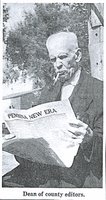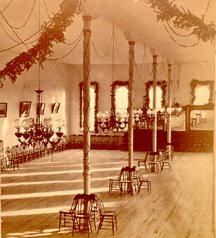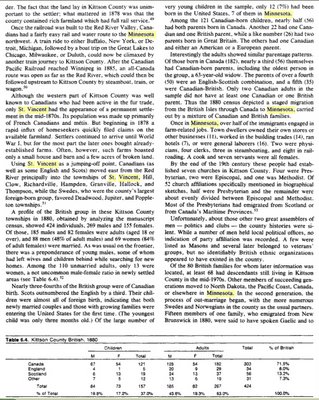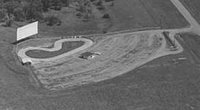
I only met Roy DeFrance a handful of times, and only in passing. He didn't look a lot different than the photo here at the left, as I remember him. He was by then, a very old gentleman, and would soon leave the running of the paper to others, including his daughter Ione.
I was a wee girl, tagging along with my Mom as she visited the Mr. DeFrance's offices to place ads or pay a subscription. I remember having the chance at least once of going behind the counter and seeing the amazing tools he had to use to make the paper.

I noticed he wore black armlets, and he explained that was to protect his shirt from the inks on the press. He also pointed out all the little wooden trays with backwards metal letters, and I must have looked flabbergasted to think of all
the work he must have to go to, to put a paper 'to bed', because he then said he's been at it for awhile and can go pretty fast. It still amazed me, and does to this day, and when I remember those visits, I also remember my mother saying that it wouldn't be the New Era without at least one misspelling in an issue. Well, I think we could forgive Mr. DeFrance a few errors - who of us could have done better? He sure didn't have a convenient 'spell checker' like we do nowadays!
Ione, one of his children, is the person I most remember and identify with the paper. Every week, Ione would faithfully call around all over the readership area, to get news for each town's section in the paper. It was a time-honored tradition in our area to do this. You couldn't go anywhere or have a good or bad event happen, without it being known in the New Era. It was a good tradition, even though some might think it intrusive; we were able to keep in touch with one another despite life being so busy.
A few months ago I made a point of tracking down Marjorie (DeFrance) Baker. Until then, I didn't even know Marjorie existed. When I was a kid, you don't even think about how many kids an old person may have had, so didn't think Mr. DeFrance had any other children than Ione! Anyways, through Fort Pembina Historical Society contacts, I found out about her in my efforts to do more history about the New Era. Below is a fairly verbatim summary of what transpired during our telephone interview...
She is 96 years old, has a great memory, and was wonderful to speak with. Was great in sharing about the paper and her father, and her involvement with the New Era as a young person.
She said her family was of French Huguenot ancestry, first settling in Pennsylvania, then coming to Minnesota. Her father - Roy DeFrance - was a short man, 5'6". "He always wore a mustache..." and had black curly hair as a young man. He started out as a teacher, and it was at a teacher's convention that he met his future wife. But eventually he went to telegraphy school in St. Paul to make a better future for himself and his family. Later, he taught my great uncle telegraphy in a depot school.
 In 1920, Mr. Deacon (seen here at left, in an early photo of the New Era offices when they were in St. Vincent (and the paper was known as The St. Vincent New Era...) sold the paper to her father. Marjorie was unable to say why her father changed careers and went from teaching to being a newspaper man, but going by his later reputation, I would speculate it must have been because Roy DeFrance had the desire and ability to express himself in the way only a newspaper publisher can. He became known for his editorials, and prided himself in providing a needed and appreciated service to his community.
In 1920, Mr. Deacon (seen here at left, in an early photo of the New Era offices when they were in St. Vincent (and the paper was known as The St. Vincent New Era...) sold the paper to her father. Marjorie was unable to say why her father changed careers and went from teaching to being a newspaper man, but going by his later reputation, I would speculate it must have been because Roy DeFrance had the desire and ability to express himself in the way only a newspaper publisher can. He became known for his editorials, and prided himself in providing a needed and appreciated service to his community.
Roy and Eva DeFrance had eight children, three girls and five boys: Norton, who worked as a printer while in the army during WWII, and afterwards worked in various print shops; Melvin, who became a reporter and also has worked as a ghost writer; Roy, who worked in the field of Linotype; Ralph, who lives in San Diego, California and runs the DeFrance Publishing Company; Dilbert, who began professionally at the New Era, then went on to work for the Grand Forks Herald; Ione, who never left the New Era; Majorie herself, a homemaker; and Gladys, their sister (no profession was mentioned for her...)
Marjorie continued by telling me how all of the DeFrance siblings were involved in one way or the other with the family business as they were growing up. Marjorie herself remembers taking singles (plain 12"x15" sheets) and wrapping copies of the paper, addressing them to subscribers, and even making deliveries. Later, she got the chance to do some reporting. She described to me seeing her father, Cecil (aka "Casey") Cleem, and Ione doing the typesetting for the print runs. Speaking of print runs, every print run required them to grease the press, which was quite a job in itself! She said she would help with the print runs sometimes, standing on a stool and feeding the press sheets, which were processed by hand-crank; if you missed a sheet, the bed got over-inked and would gum up...and her Dad would get plenty mad!
Majorie says, if she remembers rightly, one of their old presses is now in a museum, but she couldn't remember if it was the Kittson County Museum in Lake Bronson, Minnesota, or the museum in Cavalier...
We ended our telephone call agreeing I would call her this summer and make plans to meet her. She said she has a lot of memorabilia about her family and the New Era she would like to share with me, and I told her I'd love to see it, and have a chance to talk more with her. Alas, I was not able to make it up home this summer, but will be next summer due to the Humboldt centennial and all-school reunion. Let us hope and pray that I get the chance to see Marjorie then...














